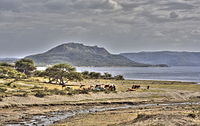
Photo from wikipedia
Two Gram-stain-negative, motile with single polar flagellum, rod-shaped bacterial strains, named SJ-9T and SJ-92T, were isolated from saline soils from Inner Mongolia, PR China. SJ-9T and SJ-92T grew at pH… Click to show full abstract
Two Gram-stain-negative, motile with single polar flagellum, rod-shaped bacterial strains, named SJ-9T and SJ-92T, were isolated from saline soils from Inner Mongolia, PR China. SJ-9T and SJ-92T grew at pH 6.5-10.0 and 7.0-11.0, 10-35 °C, and in the presence of 0-5 % and 0-8 % NaCl, respectively. Both strains were positive for oxidase, and negative for catalase. The results of phylogenetic analysis based on 16S rRNA gene sequences indicated that SJ-9T clustered with Luteimonas marina FR1330T (sharing 97.9 % 16S rRNA gene similarity), Luteimonas huabeiensis HB2T (96.5 %), 'Luteimonas wenzhouensis' YD-1 (96.6 %), and Luteimonas composti CC-YY255T (95.1 %), and shared low 16S rRNA gene similarities (<97.0 %) with all the other type strains; while SJ-92T clustered with Luteimonas aestuarii B9T (98.2 %), and shared low 16S rRNA gene similarities (<98.0 %) with all the other type strains. The two strains shared 97.4 % 16S rRNA gene similarity with each other. The major cellular fatty acids of both strains are iso-C15 : 0 and summed feature 9 (C16 : 0 10-methyl and/or iso-C17 : 1ω9c). The major polar lipids of both strains are diphosphatidylglycerol, phosphatidylglycerol and phosphatidylethanolamine. The only respiratory quinone for both strains is ubiquinone-8 (Q-8). The genomic DNA G+C contents are 69.3 and 70.4 mol%, respectively. The digital DNA-DNA hybridization (dDDH) and average nucleotide identity by blast (ANIb) values between the two strains were 22.6 and 77.5 %, while the values between SJ-9T and 'L. wenzhouensis' YD-1, L. marina FR1330T, and L. huabeiensis HB2T were 38.1, 39.2, and 21.9 %, and 82.5, 84.4, and 78.5 %, while those between SJ-92T and L. aestuarii B9T were 21.3 and 76.7 %. On the basis of the phenotypic, physiological and phylogenetic results, SJ-9T and SJ-92T represent two novel species of the genus Luteimonas, for which the names Luteimonas saliphila [type stain SJ-9T (=CGMCC 1.17377T=KCTC 82248T)] and Luteimonas salinisoli [type strain SJ-92T (=CGMCC 1.17695T=KCTC 82208T)] are proposed.
Journal Title: International journal of systematic and evolutionary microbiology
Year Published: 2022
Link to full text (if available)
Share on Social Media: Sign Up to like & get
recommendations!